In one of my earlier posts on Lahore’s old books shops, Adil Najam raised an interesting point and suggested that Pakistan is ripe for an Amazon.com type service for selling and buying old books and young Pakistani entrepreneurs should think about it. I don’t know if anyone has started such book selling service in Pakistan but I did come across this wonderful online store, Al Rug , selling handmade carpets. Two young entrepreneurs from Islamabad, one of them is an old friend of mine Yasir Hussain, came up with the idea of marketing and selling Pakistani handmade carpets to Europe and Americas through an online store.
At that time, not many people believed that Europeans and Americans would buy such an expensive product from a Pakistani online store. But hard work and honesty does pay off and, now, its amazing to see the huge success of this unique online store after three years. Definitely a wonderful example to follow. Many of you probably know that the handmade carpets of Pakistan, and particularly of Lahore, are one of our major export items and earning us huge revenues each year.
The gifted artists of Pakistan have the ability to produce ANY kind of carpet. Pakistan is fortunate enough to be blessed with such highly skilled artists, the main requirement for this industry, so the demand remains all time high. The Government of Pakistan is also encouraging this industry through various means. I know that SMEDA and some of the banks are offering easy loans and technical assistance to craftsmen/women for the purpose of setting up their own businesses. For ATP readers interest and information, let me share some background information, present situation and the challenges, including child labor, facing Pakistan’s handmade carpet industry.
Introduction
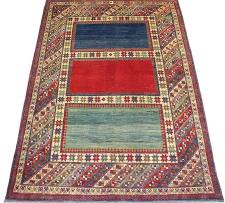 Pakistan is amongst the world’s largest producers and exporters of hand-knotted Oriental carpets. In the last few decades, Pakistani carpets have reached the farthest corners of the world.
Pakistan is amongst the world’s largest producers and exporters of hand-knotted Oriental carpets. In the last few decades, Pakistani carpets have reached the farthest corners of the world.
Contrary to widespread belief, the art of weaving developed in the region, comprising Pakistan, at a time when few civilizations knew about it. Excavations at Moenjodaro and Harappa – ancient cities of Indus Valley civilization – have established that the people knew the use of spindles and spun a wide variety of weaving materials. In fact, some historians are of the view that it was the Indus Valley civilization that of the first time developed the use of woven textiles.
The tradition of textile weaving has survived in the shape of folk culture in various parts of Pakistan. The textile designs, architecture and characteristic of our folk culture point to the floral and geometric patterns that are basic to carpet designing. This clearly shows that the art of carpet-making and designing existed in the region from very old times.
Islamic Heritage
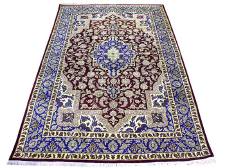
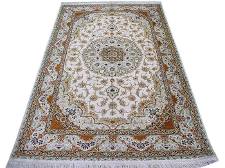
Carpets have, from the beginning, been a part of the Islamic culture as it achieved unprecedented heights in Baghdad, Damascus, Cordoba, Delhi and in the fabled cities of Central Asia. They were predominantly used to cover the floors of mosques and houses, and were occasionally used as wall decorations. The first half of the 16th century is considered the ‘Golden Age’ of Persian carpets, when large carpets with rich colors and complex designs were produced out of factories in Iran. As a result, carpet weaving in Orient was perfected to fine art in Persian and Turkish regions and their were the first to be recognized as Islamic carpets.
Mughal Tradition
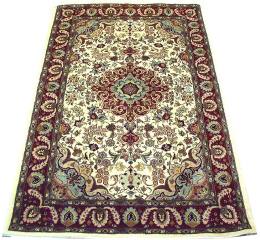 The recent carpet weaving history of Pakistan goes as far back as the inception of Mughal Dynasty, when the last successor of Timur, Babar, extended his rule from Kabul to India, to found the Mughal Empire in the early 16th century. However, many historians believe that carpet making was first introduced to the region in the 11th Century with first Muslim conquerors, the Ghaznavids and the Ghauris from the West. Established Carpet weaving in Indo-Pak Sub-Continent started under the patronage of the Mughals, when Indian craftsmen adopted Persian techniques and designs. The carpets woven in Punjab at that time – often called Lahore carpets – made use of the motifs and the decorative style found in Mughal architecture.
The recent carpet weaving history of Pakistan goes as far back as the inception of Mughal Dynasty, when the last successor of Timur, Babar, extended his rule from Kabul to India, to found the Mughal Empire in the early 16th century. However, many historians believe that carpet making was first introduced to the region in the 11th Century with first Muslim conquerors, the Ghaznavids and the Ghauris from the West. Established Carpet weaving in Indo-Pak Sub-Continent started under the patronage of the Mughals, when Indian craftsmen adopted Persian techniques and designs. The carpets woven in Punjab at that time – often called Lahore carpets – made use of the motifs and the decorative style found in Mughal architecture.
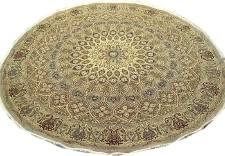
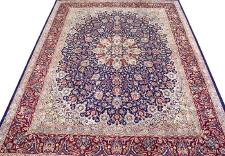
During the Mughal period the carpets made in the Indo-Pak Sub-Continent became so famous that there was a mounting demand for them abroad. These carpets had a distinctive design and boasted a rich knotting density. The carpets made for the Mughal emperors, including Jahangir and Shah Jahan, were of the finest quality. It was during Shah Jahan’s reign that Mughal carpet weaving took on a new aesthetic and entered its classical phase.
Economic Factor
Handmade carpet/rugs often labeled as ‘exotic’, like those vintage rugs, are a highly decorative and luxurious form of ornaments. The handmade carpets produced in Pakistan are mainly for the purposes of export to Western economies, and one of the major earners of foreign exchange amounting up to 300 million dollars annually (3.4% share in total exports in 2002). Due to the high-price factor, the local consumption of the handmade carpets is almost non-existent.
As every knot is tied by hand, carpet manufacturing calls for patience as it may take many months (sometimes years depending on the size and quality of the carpet/rug) before a carpet is completed and may return the investment. Costs, time and HR factor combined makes it less preferred business in modern days. In addition, the risk factor that a carpet may sell after many years of completion makes it even riskier for itchy businessmen of today’s fast-paced marketplace.
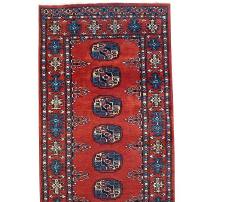
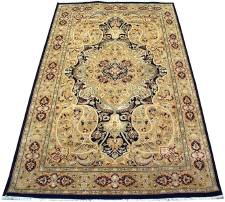
The decline in Pakistan’s textile exports and the fact that they are fetching lower prices than other competitor countries of the region, has affected carpet industry too. Foreign customer is not ready to up the prices due to overall economic slump, and locally the price-hike has made it impossible to produce carpets at the desired prices. All these elements, and a monopoly of bigger players has resulted in many small traders exiting the industry decreasing the overall capacity to almost 60-70%.
Socio-economic Factor
According to 2003 estimates, carpet manufacturing provides jobs for 1.5 million people in the country, majority of which is in poor rural areas. The reason why carpet weaving has been a major source of living for these people is that it does not require resource beyond basic infrastructural facilities to weave carpets i.e. a loom, wool and basic weaving tools. It has become a cottage industry where carpets are weaved in homes, often employing womenfolk in rural areas. It requires a few weeks training to learn to weave a carpet but it would take many years expertise to master the skill. As most of the setups are installed in homes, womenfolk and children also contribute to the work. Due to financial reasons, these folk have little source of earning beside minimal agriculture. These carpets are then transported to major cities like Lahore, Multan, Karachi and Peshawar for selling.

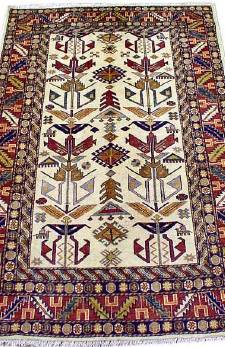
A weaver is considered at the bottom of this food-chain and is least benefited from this sport. Inhuman conditions and lowly paid work-hours makes the life harder for them, and they are physically considered ‘finished’ after 15~20 years of weaving carpets. They are another victim of overall lack of importance given by the Government to the micro-level employees, while the exporters fetch hefty profits for their investments.
Child Labor and other Challenges of Today
In the face of today’s challenges, there was a dire need to re-model the whole business strategy behind carpets to keep this ages old tradition alive in Pakistan. With the advent of technologies, reaching out to end-customer was not feat at all and could be achieved without bigger investment, given a solid marketing strategy. Al Rug, though not first one to use B2C model rather than relying on B2B, has been an example. Their vision is to give home users all around the world a ready access to its inventory and the facility to shop online. Customers are offered a wide range of oriental carpets/rugs to choose from different regions, make, colors and styles, and once an online payment is made, carpet is delivered to their doorstep – almost anywhere in the world – in just three days. I personally think their prices are reasonably OK as they are 300-400% lower than those found in US/European market for an equivalent quality handmade oriental rug. I know their target market is mainly USA and Europe but still, not every Pakistani can afford to buy what they are offering :). Perhaps, introduction of more products with a bit more affordable rates for local market would not be a bad idea at all.
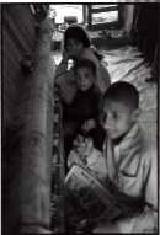 Another important challenge facing this industry is the child labor issue (also see here). It is widely believed that soft hands of children produce the best ever handmade carpets and rugs. Children of age 7-12 have been and still, to some extent, being used by this industry to produce carpets and rugs.
Another important challenge facing this industry is the child labor issue (also see here). It is widely believed that soft hands of children produce the best ever handmade carpets and rugs. Children of age 7-12 have been and still, to some extent, being used by this industry to produce carpets and rugs.
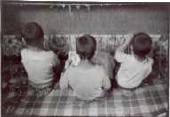 Due to the awareness and pressure put by international organizations and local human rights activists, the Government of Pakistan has taken a number of steps and the situation has improved significantly. Many Pakistani exporters are being extra careful and they do not deal with local manufacturers who employ children to produce carpets. A lot still needs to be done to free this industry completely from child labor.
Due to the awareness and pressure put by international organizations and local human rights activists, the Government of Pakistan has taken a number of steps and the situation has improved significantly. Many Pakistani exporters are being extra careful and they do not deal with local manufacturers who employ children to produce carpets. A lot still needs to be done to free this industry completely from child labor.
But coming back to the bright side of topic, it is only possible with a vision and clinical execution that we can make the world turn to the art produced in our country and ages old traditional crafts. What two young entrepreneurs from Islamabad have done can be replicated all over the country. Any future entrepreneurs listening?
Note: Click on the image for enlarged view

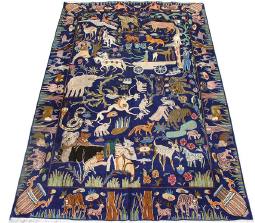
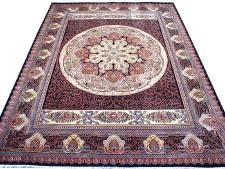
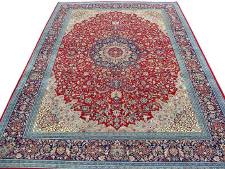




















































hi,
i am interested of your carpets, they are amazing, could you send me some more models ( except that in your syte which i already have seen) , i am interested of Cristian Hystoric Models, i am colectioner and i have many of Pakistan Carpetsts( almost 23), but i still looking for sometnhing new . Thanks, tel for contact +44 77 535 51 530.Could you send me also the price list with your carpets model list pls?
Regards
E. Bayraktarova
Some of the carpets are really beautiful. its very difficult to manage payments and the quality of carpets that a customer receives.
Our company China Silk Industrial & Trading Corporation(CSITC) which is a serious import and export enterprise found in 1987,mainly deal in the silk product from silk cocoon to silk garment in the whole line. Except the international business, we also act as the silk association in china to communicate with many partner from worldwide on the silk actuality and future. Based on high reputation on financial credit in the whole silk industrial circle. we try our best to offer customer the best service and product.
Here I’d like to introduce our silk and wool carpet yarn products for you, hope you like it and bring you more business opportunity.
NATURAL SPUN YARNS:
Worsted spun silk yarn from 1Nm to 210Nm with perfect quality from 100% Chinese traditional mulberry silk and tussah silk. Lower count (under 30Nm) is usually used for luxurious carpet or hand-made rug or decorated home textile products by customer, such as 2Nm, 8Nm, 10Nm, 15Nm, 24Nm, 30Nm….Higher count yarn can be woven into high quality fabric used in various field. Current minimum order is 200kgs.
Based on our factory with over 60years production history with rich experience, now the yarn we are offering are very good quality with shiny silk shade, firmness, evenness and equal length fibre, which is satisfied by carpet factory, weaving factory and other traders. From the material to the production line to finish yarn product there are 20stages, in each stages we have special team to control the quality and check every stage timely to guarantee that the final silk yarn is what our customer wants. Currently we have 60Nm, 140Nm in hand, other counts need to make on orders. If you like it or have interest, please freely contact me. Delivery time in in 20days from your wire our the prepayement.
Except pure silk carpet yarn, we are also a professional silk/wool, silk/cashmere, silk/cotton,blended yarn supplier, the blended yarn from us is even color, even shine and even twist, counts, hope you like them.
FILAMENTS
100% degummed thrown silk filament in various specification, such as: 20/22D x 12 x 2, 20/22Dx8x2, 20/22Dx18x3, 40/44Dx9x3
In response of Aysha,
I am Manufacturers and Exporters of hand knotted Pakistani and Afghani Carpets.
I started a compeign againest child Labour and as yours ideas I also decided that I will not take any carpets weaved by children.
I visited many of our looms in punjab and north west of Pakistan. There I surprised to see that 40 percent carpets are being made by children.
I raised a Issue of Child labour but can do nothing and thats why because the 40 % children are sustaining their faimlies they helped their sisters, mother, father, brother and other one for sustaining their faimly.
We are here and say easily that this is a serious issue of child labour but can not understand their problems.
They also heart and they t wants to stay at home In a hot summer and in bitter cold but their compelsion does not allow to them that they stay at home.
You know that many of them just weaved carpets and get daily meal. Here how we raised this issue.
In experience and In listen there is a big diffrence.
We can not solve this issue untill we solve the problems of remote areas of specially 3rd world country.
I have heard about Care & Fair doing something on child labor. What about them? These carpets, no doubt, are gorgeous!